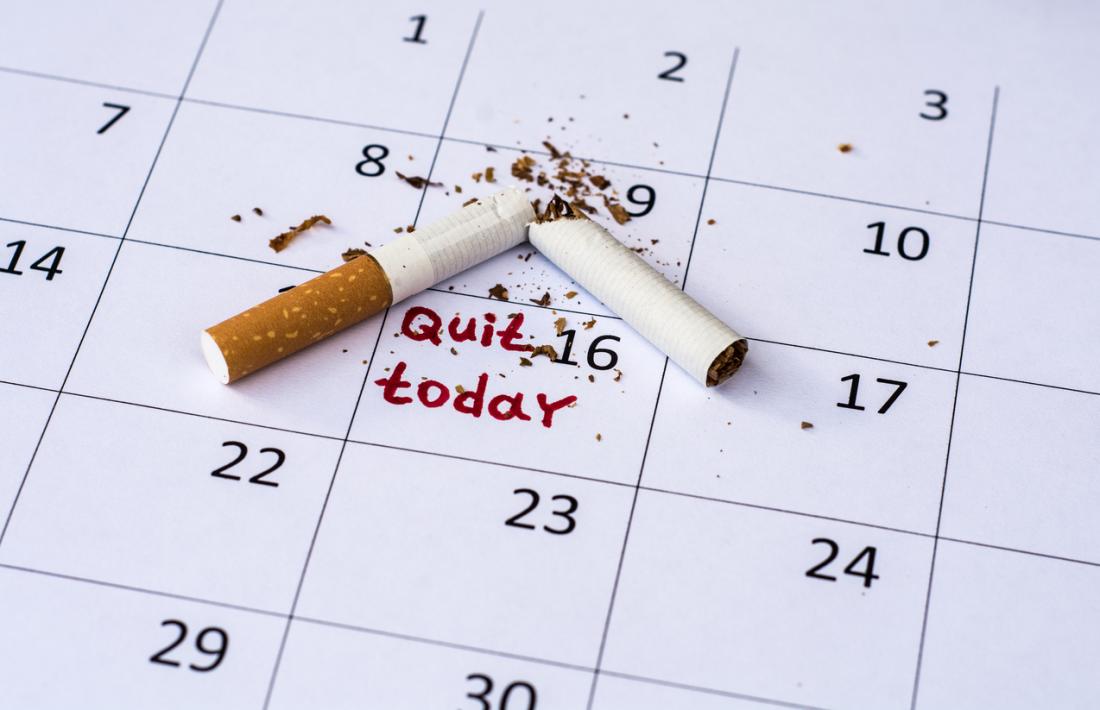1. Prepare for quit day
Once you have decided to stop smoking, you are ready to set a quit date. Pick a day that is not too far in the future (so that you do not change your mind), but which gives you enough time to prepare.

Choose your quit date and prepare to stop smoking altogether on that day.
There are several ways to stop smoking, but ultimately, you need to decide whether you are going to:
Here are some tips recomanded by the American Cancer Society to help you to prepare for your quit date:
Daily activities - such as getting up in the morning, finishing a meal, and taking a coffee break - can often trigger your urge to smoke a cigarette. But breaking the association between the trigger and smoking is a good way to help you to fight the urge to smoke.
On your quit day:
You will almost certainly feel the urge to smoke many times during your quit day, but it will pass. The following actions may help you to battle the urge to smoke:
Remembering the four Ds can often help you to move beyond your urge to light up.
2. Use NRTs
Going cold turkey, or quitting smoking without the help of NRT, medication, or therapy, is a popular way to give up smoking. However, only around 6%of these quit attempts are successful. It is easy to underestimate how powerful nicitine dependences really is.

NRTs can help you to fight the withdrawal symptoms associated with quitting smoking.
NRT can reduce the cravings and withdrawal symptoms you experience that may hinder your attempt to give up smoking. NRTs are designed to wean your body off cigarettes and supply you with a controlled dose of nicotine while sparing you from exposure to other chemicals found in tobacco.
The U.S Food and Drug Administration (FDA) have approved five types of NRT:
If you have decided to go down the NRT route, discuss your dose with a healthcare professional before you quit smoking. Remember that while you will be more likely to quit smoking using NRT, the goal is to end your addiction to nicotine altogether, and not just to quit tobacco.
Contact your healthcare professional if you experience dizziness, weakness, nausea, vomiting, fast or irregular heartbeat, mouth problems, or skin swelling while using these products.
3. Consider non-nicotine medications
The FDA have approved two non-nicotine-containing drugs to help smokers quit. These are bupropion (Zyban) and varenicline (Chantix).

Bupropion and varenicline are non-nicotine medications that may help to reduce cravings and withdrawal symptoms.
Talk to your healthcare provider if you feel that you would like to try one of these to help you to stop smoking, as you will need a prescription.
Bupropion acts on chemicals in the brain that play a role in nicotine craving and reduces cravings and symptoms of nicotine withdrawal. Bupropion is taken in tablet form for 12 weeks, but if you have successfully quit smoking in that time, you can use it for a further 3 to 6 months to reduce the risk of smoking relapse.
Varenicline interferes with the nicotine receptors in the brain, which results in reducing the pleasure that you get from tobacco use, and decreases nicotine withdrawal symptoms. Varenicline is used for 12 weeks, but again, if you have successfully kicked the habit, then you can use the drug for another 12 weeks to reduce smoking relapse risk.
Risks involved with using these drugs include behavioral changes, depressed mood, aggression, hostility, and sucidial thoughts or actions.
4. Seek behavioral support
The emotional and physical dependence you have on smoking makes it challenging to stay away from nicotine after your quit day. To quit, you need to tackle this dependence. Trying counseling services, self-help materials, and support services can help you to get through this time. As your physical symptoms get better over time, so will your emotional ones.

Individual counseling or support groups can improve your chances of long-term smoking cessation.
Combining medication - such as NRT, bupropion, and varenicline - with behavioral support has been demonstrated to increase the chances of long-term smoking cessation by up to 25%
Behavioral support can range from written information and advice to group therapy or individual counseling in person, by phone, or online. Self-help materials likely increase quit rates compared with no support at all, but overall, individual counseling is the most effective behavioral support method.
Support groups, such as Nicotine Anonymous (NicA), can prove useful too. NicA applies the 12-step process of Alcoholics Anonymous to tobacco addiction. You can find your nearest NicA group using their website or by calling 1-877-TRY-NICA (1-877-879-6422).
5. Try alternative therapies
Some people find alternative therapies useful to help them to quit smoking, but there is currently no strong evidence that any of these will improve your chances of becoming smoke-free, and, in some cases, these methods may actually cause the person to smoke more.
Some alternative methods to help you to stop smoking might include:

E-cigarettes have had some promising research results in helping with smoking cessation.
E-cigarettes
E-cigarettes are not supposed to be sold as a quit smoking aid, but many people who smoke view them as a method to give up the habit.
E-cigarettes are a hot research topic at the moment. Studies have found that e-cigarettes are less addictive than cigarettes, that the rise in e-cigarette use has been linked with a significant increase in smoking cessation, and that established smokers who use e-cigarettes daily are more likely to quit smoking than people who have not tried e-cigarettes.
No comments:
Post a Comment